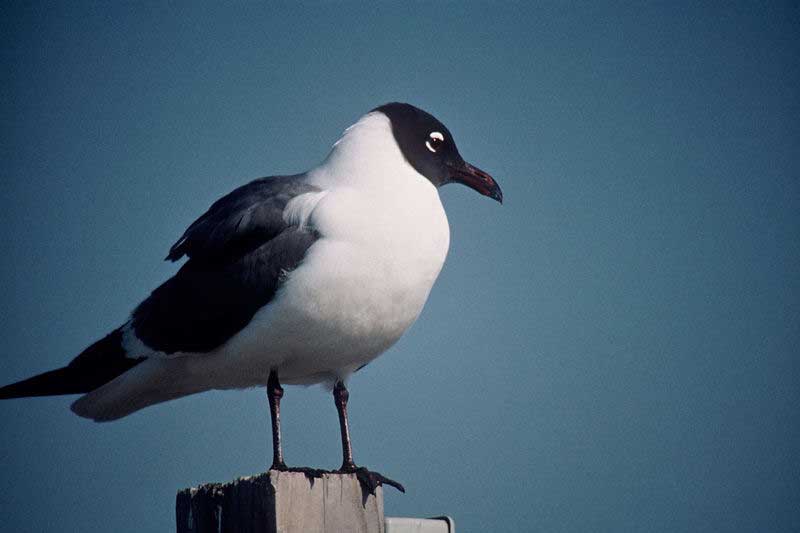
Larus atricilla (*)
Superregnum: Eukaryota
Regnum: Animalia
Subregnum: Eumetazoa
Cladus: Bilateria
Cladus: Nephrozoa
Superphylum: Deuterostomia
Phylum: Chordata
Cladus: Craniata
Subphylum: Vertebrata
Infraphylum: Gnathostomata
Superclassis: Tetrapoda
Cladus: Reptiliomorpha
Cladus: Amniota
Classis: Reptilia
Cladus: Eureptilia
Cladus: Romeriida
Subclassis: Diapsida
Cladus: Sauria
Infraclassis: Archosauromorpha
Cladus: Crurotarsi
Divisio: Archosauria
Subsectio: Ornithodira
Subtaxon: Dinosauromorpha
Cladus: Dinosauria
Ordo: Saurischia
Cladus: Eusaurischia
Cladus: Theropoda
Cladus: Neotheropoda
Infraclassis: Aves
Cladus: Euavialae
Cladus: Avebrevicauda
Cladus: Pygostylia
Cladus: Ornithothoraces
Cladus: Euornithes
Cladus: Ornithuromorpha
Cladus: Ornithurae
Cladus: Carinatae
Parvclassis: Neornithes
Cohors: Neognathae
Ordo: Charadriiformes
Subordo: Lari
Familia: Laridae
Subfamilia: Larinae
Genus: Leucophaeus
Species: Leucophaeus atricilla
Subspecies: L. a. atricilla – L. a. megalopterus
Name
Leucophaeus atricilla (Linnaeus, 1758)
Synonyms
Larus atricilla (protonym)
References
Linnaeus, C. 1758. Systema Naturae per regna tria naturæ, secundum classes, ordines, genera, species, cum characteribus, differentiis, synonymis, locis, Tomus I. Editio decima, reformata. Holmiæ: impensis direct. Laurentii Salvii. i–ii, 1–824 pp DOI: 10.5962/bhl.title.542: 136. Reference page.
Vernacular names
العربية: نورس ضاحك
български: Карибска чайка
brezhoneg: Gouelan c'hoarzher
català: Gavina capnegra americana
čeština: Racek atlantický
Cymraeg: Gwylan chwerthinog
dansk: Lattermåge
Deutsch: Aztekenmöwe
Ελληνικά: Αζτεκόγλαρος
English: Laughing Gull
Esperanto: Amerika ridmevo
español: Gaviota reidora americana
eesti: Randkajakas
euskara: Gavina capnegra americana
فارسی: کاکایی خندان
suomi: Nokisiipilokki
føroyskt: Láturmási
français: Mouette atricille
Gaeilge: Sléibhín an Gháire
galego: Gaivota chorona americana
Avañe'ẽ: Ojaja
עברית: שחף צוחק
Kreyòl ayisyen: Mòv tèt nwa
magyar: Kacagó sirály
Bahasa Indonesia: Camar tertawa
íslenska: Hláturmáfur
italiano: Gabbiano sghignazzante
日本語: ワライカモメ
lietuvių: Karibinis kiras
latviešu: Acteku kaija
Nederlands: Lachmeeuw
norsk nynorsk: Lattermåse
norsk: Lattermåke
Diné bizaad: Tónteel tsídii yidlohí
polski: Mewa karaibska
português do Brasil: Gaivota-alegre
português: Gaivota-alegre
русский: Ацтекская чайка
slovenčina: Čajka aztécka
slovenščina: Azteški galeb
svenska: Sotvingad mås
Türkçe: Gülen martı
Tiếng Việt: Mòng biển cười
中文: 笑鷗
The laughing gull (Leucophaeus atricilla) is a medium-sized gull of North and South America. Named for its laugh-like call, it is an opportunistic omnivore and scavenger. It breeds in large colonies mostly along the Atlantic coast of North America, the Caribbean, and northern South America. The two subspecies are: L. a. megalopterus – which can be seen from southeast Canada down to Central America, and L. a. atricilla which appears from the West Indies to the Venezuelan islands. The laughing gull was long placed in the genus Larus until its present placement in Leucophaeus, which follows the American Ornithologists' Union.
Name
The genus name Leucophaeus is from Ancient Greek λευκός : leukós, "white", and φαιός : phaios, "dusky". The specific atricilla is from Latin atra, "black", " unlucky" or "malevolent" and cilla, "tail".[2]
Range
It breeds on the Atlantic coast of North America, the Caribbean, and northern South America. Northernmost populations migrate farther south in winter, and this species occurs as a rare vagrant to western Europe. The laughing gull's English name is derived from its raucous kee-agh call, which sounds like a high-pitched laugh "ha... ha... ha...".[3]
Laughing gulls breed in coastal marshes and ponds in large colonies. The large nest, made largely from grasses, is constructed on the ground. The three or four greenish eggs are incubated for about three weeks.
Description
This species is easy to identify. It is 36–41 cm (14–16 in) long with a 98–110 cm (39–43 in) wingspan and a weight range[4] of 203–371g (7.2-13.1 oz). The summer adult's body is white apart from the dark grey back and wings and black head. Its wings are much darker grey than all other gulls of similar size except the smaller Franklin's gull, and they have black tips without the white crescent shown by Franklin's. The beak is long and red. The black hood is mostly lost in winter.
Laughing gulls take three years to reach adult plumage. Immature birds are always darker than most similar-sized gulls other than Franklin's. First-year birds are greyer below and have paler heads than first-year Franklin's, and second-years can be distinguished by the wing pattern and structure.
Subspecies
The two subspecies are:[5]
L. a. megalopterus – (Bruch, 1855): coastal southeast Canada, eastern & southern United States, Mexico & Central America
L. a. atricilla – (Linnaeus, 1758): West Indies to Venezuelan islands
Like most other members of the genus Leucophaeus, the laughing gull was long placed in the genus Larus. The present placement in Leucophaeus follows the American Ornithologists' Union.[6][7]
References
BirdLife International (2012). "Larus atricilla". IUCN Red List of Threatened Species. 2012. Retrieved 26 November 2013.
Jobling, James A (2010). The Helm Dictionary of Scientific Bird Names. London: Christopher Helm. pp. 59, 224. ISBN 978-1-4081-2501-4.
"Laughing Gull (Larus atricilla)". Handbook of the Birds of the World. Retrieved 29 October 2018.
"Laughing Gull Identification, All About Birds, Cornell Lab of Ornithology". www.allaboutbirds.org. Retrieved 2020-09-25.
Burger, Joanna (4 March 2020). "Laughing Gull (Larus atricilla)". Birds of the World.
"Check-list of North American Birds". North American Classification Committee. American Ornithologists' Union. Retrieved 2009-05-26.
Remsen, J. V. Jr.; C. D. Cadena; A. Jaramillo; M. Nores; J. F. Pacheco; M. B. Robbins; T. S. Schulenberg; F. G. Stiles; D. F. Stot; K. J. Zimmer. "A classification of the bird species of South America". South American Classification Committee. American Ornithologists' Union. Archived from the original on 2009-03-02. Retrieved 2009-05-26.
Retrieved from "http://en.wikipedia.org/"
All text is available under the terms of the GNU Free Documentation License

